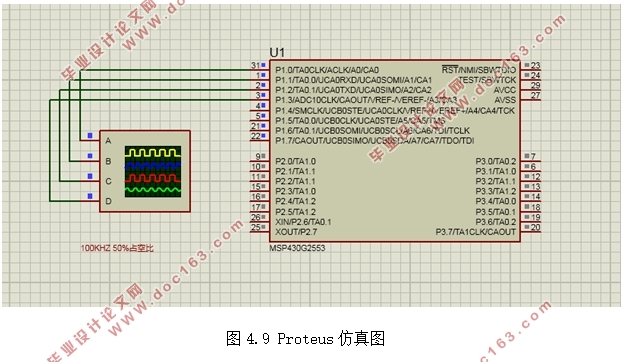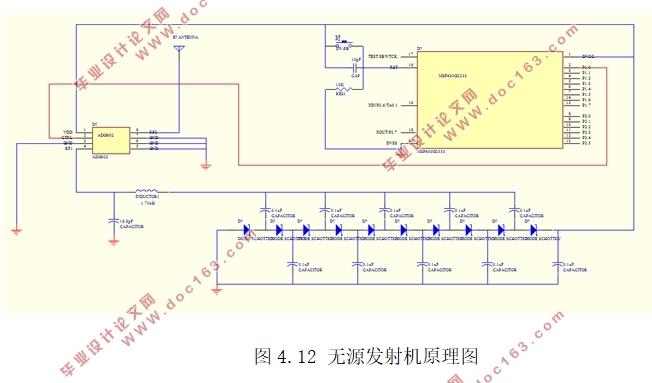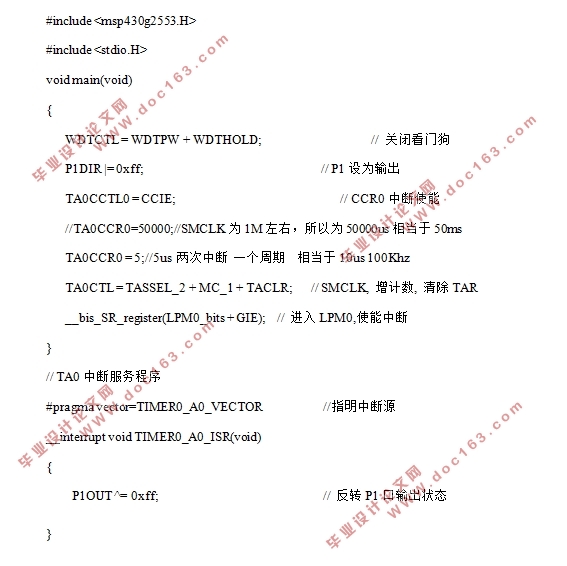环境反射通信系统设计与实现(附Proteus仿真,程序代码)

以下是资料介绍,如需要完整的请充值下载.
1.无需注册登录,支付后按照提示操作即可获取该资料.
2.资料以网页介绍的为准,下载后不会有水印.资料仅供学习参考之用.
密 惠 保
1.无需注册登录,支付后按照提示操作即可获取该资料.
2.资料以网页介绍的为准,下载后不会有水印.资料仅供学习参考之用.
密 惠 保
资料介绍:
环境反射通信系统设计与实现(附Proteus仿真,程序代码)(任务书,开题报告,外文翻译,论文15000字,Proteus仿真,程序代码)
摘 要
环境反向散射技术作为一种新型的无线通信技术,通过控制天线的阻抗来改变天线对外界射频信号的吸收或反射两种不同的状态,这种状态的改变可以被WIFI设备所检测到,因此可以间接的将标签自身的信息传输至WIFI设备,从而实现将标签中的信息传送至互联网。采用这种通信方式的优点在于由于WIFI已经实现了大范围的覆盖,这极大地降低了物联网的组网难度。
论文主要研究环境反向散射通信系统发射机的工作原理和设计方法,对构成无源发射机的各个模块做了系统的研究。设计了射频能量收集电路,结合射频仿真剖析了电路的射频性能,并设计了该电路与接收天线间的阻抗匹配网络。对比了多种型号天线的物理特性,确定了合适的天线选型。分析了ADG902射频开关在2.4GHZ工作环境下的关闭隔离和插入损耗等特性。最后采用MSP430系列单片机设计了产生开关信号的微控制器模块,以此来控制射频开关的工作状态,从而改变天线阻抗,实现对环境中射频信号的吸收与反射。
研究结果表明:无源发射机中的射频能量收集电路针对高频交流小信号有较好的升压整流作用,经过匹配后的射频能量收集电路的复阻抗为和天线的特性阻抗(50 )相同,实现了和接收天线的共轭匹配,从而可以使能量收集电路从天线端获得最大的功率输入。天线和射频开关的选型也能够较好的满足无源发射机的设计要求,微控制器模块采用超低功耗的微处理器MSP430G2553,相比其他类型的微控制器而言,能够较好的满足无源发射机的功耗限制,同时能够产生良好的开关信号控制射频开关的通断。
[资料来源:http://THINK58.com]
关键词:环境反向散射;物联网;无线通信;能量收集
Abstract
WIFI backscatter technology as a new type of wireless communication technology, through the control of the antenna impedance of RF signal to change the antenna to the outside world reflect or absorb two different state, this change of state can be detected by WIFI devices, thus indirectly to label their own information transmission to the WIFI devices, so as to realize the information in the label sent to the Internet.The advantage of adopting this communication mode is that WIFI has achieved a wide range of coverage, which greatly reduces the difficulty of networking the Internet of things.
This paper mainly studies the working principle and design method of the environmental backscatter communication system transmitter and systematically studies the modules of the passive transmitter.The RF energy collecting circuit is designed, the RF performance of the circuit is analyzed by RF simulation, and the impedance matching network between the circuit and the receiving antenna is designed.The physical characteristics of several types of antennas are compared and the appropriate antenna selection is determined.The characteristics of ADG902 RF switch in 2.4GHZ working environment are analyzed.Finally, MSP430 is used to design the microcontroller module to generate the switching signal, so as to control the working state of the RF switch, change the antenna impedance, and realize the absorption and reflection of the RF signal in the environment. [资料来源:http://www.THINK58.com]
Research results show that the passive transmitter of RF energy in high frequency ac small signal collection circuit has good boost rectifier, after matching, the RF energy collected the complex impedance of the circuit for the characteristic impedance of the antenna, implements and conjugate match the receiving antenna, which can make the energy collection circuit from the antenna gain maximum power input.Antenna and RF switch selection will also be able to better meet the requirements of the design of a passive transmitter, Low power consumption microprocessor MSP430G2553 is used as the microcontroller module.compared to other types of microcontroller,it can better adapt the power limit of passive transmitter, at the same time it can produce good switch signal control the RF switch on and off.
Key Words:WIFI backscatter;internet of things;wireless communication;the energy collection.
主要工作与章节设置
本文所做的工作,主要是借助计算机软件平台,完成环境反向散射通信系统发射机的设计和理论研究。有三个大的研究方向,一是RF能量收集电路的理论设计与仿真,二是RF能量收集电路与接收天线的阻抗匹配设计,三是环境反向散射系统整体架构的设计与研究。 [资料来源:http://think58.com]
本文的章节设置如下:
第一章为绪论,主要阐述了环境反向散射通信技术的研究背景,研究意义和该课题的研究现状。指出了本文的研究方向和主要工作。
第二章介绍了环境反向散射的原理,环境反向散射通信系统的发射机,接收机所采用的调制解调方法。
第三章完成了环境反向散射系统发射机射频能量收集电路的设计与仿真,完成了能量收集电路与天线的阻抗匹配工作。
第四章简要介绍了射频开关的使用方法以及采用射频开关,微处理器和上述RF能量收集电路搭建一个完整的发射机原型的方案。
第五章对全文所做的工作加以总结,提出了本文中一些有待改善的问题,并对后续工作进行了展望。
[资料来源:http://www.THINK58.com]




目 录
第1章 绪论 1
[版权所有:http://think58.com]
1.1 研究背景和意义 1
1.2 国内外研究现状 2
1.3 主要工作与章节设置 2
第2章 环境反射通信系统基本工作原理 4
2.1 环境反向散射通信技术概述 4
2.2 上行链路调制解调原理 5
2.3 下行链路调制解调原理 6
第3章 RF能量收集电路设计与仿真 7
3.1 RF能量收集电路设计 7
3.2 RF能量收集电路性能研究 8
3.3 阻抗匹配 13
第4章 无源发射机设计 19
4.1 接收天线与射频开关评估与选型 19
4.2 微控制器模块设计 22
4.3 无源发射机结构设计 24
第5章 总结与展望 26
5.1 总结 26
5.2 展望 26
参考文献 28
附录A 29
致谢 30 [资料来源:http://www.THINK58.com]
